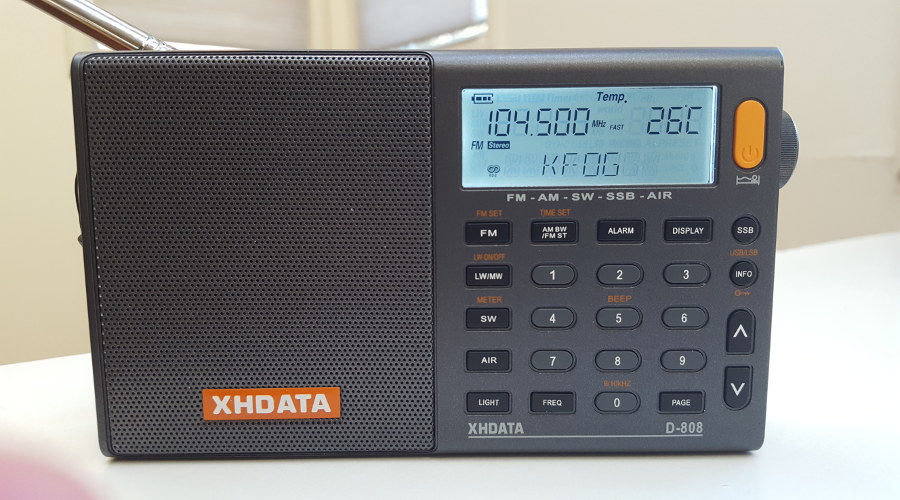
In our current age of global trade and prolific Chinese radio manufacturers, it was surprising to discover how difficult it was in 2018 to obtain the XHDATA D-808 in the United States, even while it was available in most of the rest of the world. For much of 2018, the primary - if not the only - way to acquire this radio for those living in the United States was through an eBay seller based in Israel. This unusual channel of distribution led to some speculation about the reasons that the radio wasn't available in the United States.
The fact that the radio has many of the same capabilities as C. Crane's Skywave line of radios led some observers to conclude that the XHDATA distributor was trying to avoid problems with C. Crane, such as disputes over intellectual property, by not shipping the D-808 to the United States. Subsequently, the XHDATA distributor, Radiwow, began selling the Radiwow R-108 worldwide, which resembled the CC Skywave even more closely, giving new life to assertions that the XHDATA radio is a copycat, too.
A few years later, the primary channel for XHDATA sales to North America became eBay sellers based in China, which is a somewhat easier channel to work with in most cases.
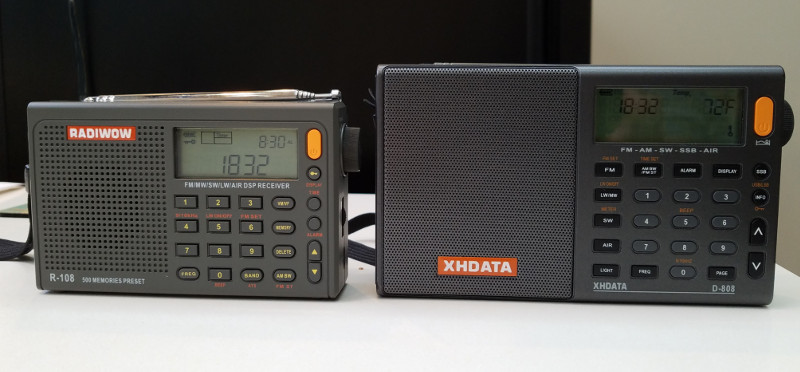
Even with the controversy regarding a possible copycat model, the Skywave radios, both with and without single-sideband (SSB) reception capability, differed from the XHDATA D-808 in some of the features offered. The D-808 also was one of the first portable DSP-based radios to offer RDS (Radio Data Service) reception capabilities for FM stations. The D-808 is also bigger than the CC Skywave models. (It's also bigger than its sibling, the Radiowow R-108 - see photo above.
Moreover, the Australian retailer Jaycar has sold a model very similar to the D-808, the Digitech AR-1780. In mid-2018, Jaycar began direct sales to the United States, which made the Digitech radio easier to obtain for American buyers compared to the XHDATA radio. However, by 2023, Jaycar had discontinued such sales, making the Digitech radio more difficult to get outside Australia or New Zealand.
My review of the Digitech model indicates that it is nearly identical to the XHDATA D-808, with slightly richer sound from the built-in speaker, and using standard AA batteries rather than a lithium-ion battery.
Let's examine the D-808 in more detail.
I ordered two D-808 units through the Israeli reseller, at a cost of around $130 each, including shipping. The radio comes with a fake-leather carrying pouch, a plug-in longwire antenna intended for shortwave use, and a USB cord for charging the battery in the radio. No earbuds are included, but I don't care about that.
The dimensions of the D-808 are 157 millimeters (6 3/16") wide by 92 millimeters (3 5/8") wide, with a depth of 32 millimeters (1 1/4"). The antenna is 25 1/2" (65 mm) long - still not the right length for FM reception (this is something even C. Crane gets wrong on the Skywave). Still it's longer than other, smaller DSP-based radios.
The leftmost column of buttons on the keyboard are for band selection, except for the bottom button, which turns the display backlight on and off. A numeric keypad provides direct access to memory storage, which is arranged in 10 groups (selected with the PAGE button) of 10 positions each. The same keypad is used to access stations directly by frequency after the FREQ key is first pressed. An automatic search function (ATS) is also provided. These methods of station selection closely resemble those of the CC Skywave. One unique feature compared to other radios of this type is the ability to manually select between temperature readings in Celsius or Fahrenheit - with the radio off, press 3 to toggle between those units of measurement.
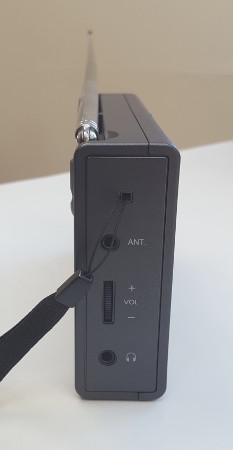
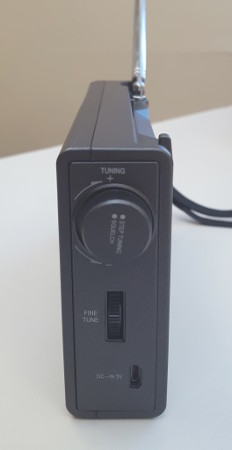
One slightly annoying characteristic of this radio is a nearly two-second pause in audio when switching between bands. This is far more than other DSP-based radios. Is there some kind of buffering that's occurring? While not a major defect, it is a little surprising at first, though I became quickly accustomed to it. Likewise, when first turning on the radio, there's about a two-second delay before audio starts.
The AM BW/FM ST button is used on FM to force reception in mono for a quieter signal, and on AM to toggle through reception bandwidths of 6, 4, 3, 2.5, 2, 1.8, or 1 kHz. The choice of seven bandwidths is the most of any DSP radio, except the very similar Digitech AR-1780. Unlike the CC Skywave, or the Radiwow R-108, there's no "music/voice" tone selection. Fortunately, the XHDATA has a larger speaker and a more balanced sound than most other DSP-based radios. It's actually pleasant to listen to this radio through the built-in speaker. I can't say the same for the CC Skywave or any of the Tecsun radios that I have.
The left side of the radio has an antenna jack for FM or shortwave, a volume control, and a headphone jack. The latter two are inconveniently placed for strongly right-handed people like me. However, the right side of the radio is taken up with a tuning knob, plus an additional fine-tuning control, and a USB jack for charging. It's natural for the fine-tuning thumbwheel to be next to the tuning knob, but it doesn't feel natural (to me) to have the volume control on the left side.
This unit uses a lithium-ion battery. This is where things get confusing. The battery is a 3.7-volt battery, type 18650, capacity 2000 milliampere- hours, pictured below. However, there's more than one type of 18650 battery. This unit makes use of the "button top" variety. There's also a "flat top" version that won't work for this radio.
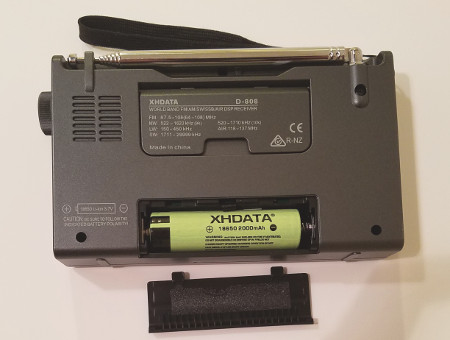
One big disadvantage of the D-808 became apparent over time: relatively fast battery drainage even when the radio had not been in use. I don't care for lithium-ion batteries in radios anyway (see the Radiwow R-108 review for my reasoning). I noticed that the battery in my first D-808 would drain completely in 14 to 18 days even if the radio was not turned on during that time. I first thought there was a problem with the battery, so I tried a slightly higher capacity (2600 milliampere-hours) battery. That battery barely fit the battery compartment - I could see the battery door buckle slightly. I was afraid that the door might eventually break under the stress. Moreover, the battery drained down just as quickly as before. So I tried a 2200 milliampere-hour battery, which did fit, but which drained almost as quickly as the other batteries.
In my second unit, the drain was slower, taking about five weeks. That was better, but still disappointing considering that the CC Skywave and my Tecsun units can last months when idle. One might first think that it's the lithium-ion battery that's the issue, but I've reached the conclusion that the battery isn't the problem; something is draining the battery faster than it should. I suspect it's either the display or the clock. There also seems to be some sample variation here. You may get lucky, or you may not. Fortunately, station memories remain stored even if the battery runs completely down. Time and alarm settings are lost.
Problems with battery drainage have continued in the months since I first wrote this review. Those problems raise questions about the long-term reliability of this model. The nearly identical Digitech AR-1780 uses standard "AA" batteries. It appears to have fewer issues with battery drainage.
I finally became fed up with the battery drainage and sold the units in 2023. Oddly, by that time, older models of the D-808 became more desirable than newer ones, due to changes that XHDATA made to the design and circuitry of the radio. There have been complaints on various DXing forums that the new XHDATA model does not perform as well as the older model. Comments in this review are for the older D-808 design. I'm not buying a new one, given the battery problems that I had.
The problem with the battery spoiled what otherwise is a very pleasing radio to tune and to listen to. There are few digital-synthesis noises. FM reception is on par with other DSP radios, but with a twist that requires some explanation. When considering just the ability to pick up a listenable signal, the XHDATA D-808 is slightly better than the CC Skywave, but, in turn, is slightly less capable as a performer than the DSP models from Tecsun.
However, if the radio supports FM stereo reception, you need to consider its performance in stereo. Recall that weaker FM signals, and even signals of moderate strength, have a higher level of background noise in stereo compared to mono. To put it another way, a higher signal strength is required to get noise-free reception in stereo compared to mono.
It's in FM stereo reception where the XHDATA D-808 falls short. Its threshold for stereo reception is set to be unusually high. This could be considered a positive thing by some, because this effect ensures that FM stereo is relatively free from noise. Earlier generations of FM radios, such as the Proton 100 and Sony Walkmans, as well as current-day DSP-based radios, set the threshold for stereo at a level that allows stereo reception even if some background noise results.
If this is a conscious design decision, it's hard to understand, because the XHDATA D-808 is able to force mono reception for all FM signals. It also makes it a little more difficult to compare the XHDATA radio's reception performance to other radios. If you don't care about stereo reception - for example, if you always use the speaker to listen to the radio - it won't matter to you. But if you use headphones to get stereo reception, it may matter a lot. To summarize, the XHDATA D-808 is a very good performer for FM mono reception, but for stereo reception, I have to knock down my evaluation by a notch. The nearly identical Digitech AR-1780 exhibits the same FM reception characteristics.
On the other hand, AM reception was the best I've heard from a DSP radio until the Tecsun PL-320 came along in 2023. There is room for a bigger loopstick in the D-808, and it makes a difference - not a huge difference, but noticeable nonetheless.
I made several head-to-head comparisons of the XHDATA D-808 to the CC Skywave, the Tecsun PL-310ET, and the Tecsun PL-380. All were strong FM performers (in mono), with the PL-380 having a slight edge over to the rest. The XHDATA D-808 performed slightly better than the CC Skywave, and is slightly less sensitive than the Tecsun models. Both Tecsun models were definitely top performers for FM stereo reception.
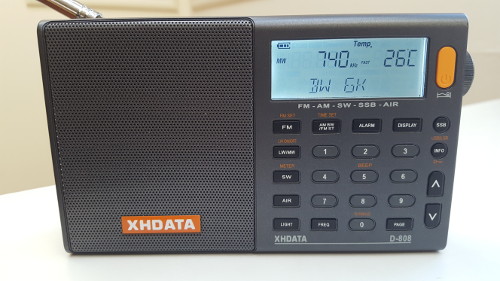
I found AM reception to be comparable with other DSP-based radios such as the Tecsuns I've already mentioned as well as the CC Skywave. The XHDATA units seem to do a bit better than the others in getting stronger audio from fringe signals. In my area, KHTK (1140) Sacramento is one of those signals, as was KLIV (1590) San Jose when it was at full power. KLIV is now on low power after a transmitter move.
Since I live in a busy metropolitan area with plenty of signals, the results I get from testing can sometimes feel misleading. I had the opportunity to do a head-to-head comparison of FM reception between one of my XHDATA radios and the Tecsun PL-380 in Paso Robles, California during a brief vacation toward the end of 2018. Even at a more challenging location, the XHDATA and the PL-380 were very close, with the PL-380 being the better performer. Even so, the XHDATA was able to get the same stereo-capable signals as the PL-380 for the most part. I didn't have a chance to try out AM reception during that particular trip. I try to test AM reception at midday, but the November days were short and we were busy during the daytime anyway! Paso Robles would have made a good test case for AM reception since there is only one strong local AM station in the area. I was able to do some nighttime listening, and found the multiple bandwidths on the XHDATA to be useful, with good automatic gain control and audio recovery.
Ultimately, though, I sold the radios in 2023. I got tired of keeping a close eye on the battery indicator, charging this radio far more often than others. For FM stereo listening of weaker signals, I would prefer Tecsun or C. Crane models. Between the battery problems and FM stereo quirks, I'm now hesitant to recommend this radio. That's unfortunate, because it otherwise had so many things going for it, at least in its original version. Reports I've read about "updates" to the radio's design aren't encouraging, either. At the same time, a lot of DXers really like this radio. I find it a little odd that my experience with it has been so much worse than theirs, so you may want to do some research before buying the XHDATA D-808.